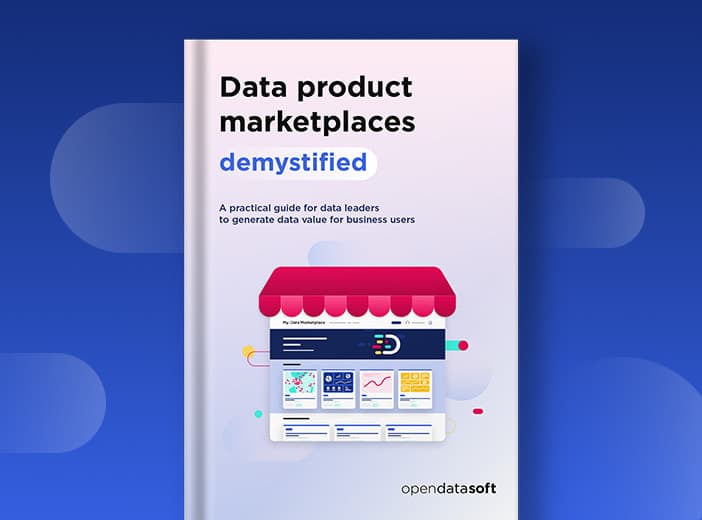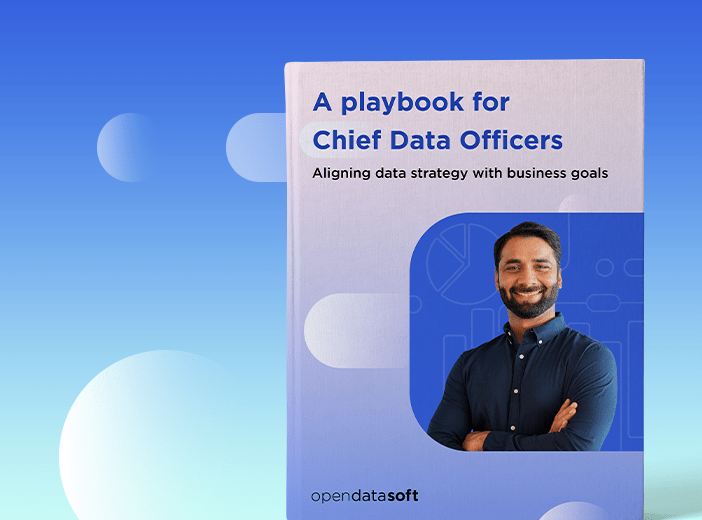Generating value from data through a data product marketplace

Data product marketplaces empower businesses and data leaders with the ability to industrialize data sharing and consumption to create data value. We look at the key foundations you need to put in place to ensure your data product marketplace successfully generates value, increases usage and drives ROI.
Across every sector, organizations understand the need for greater data sharing at scale to drive improved efficiency, better decision-making, greater collaboration and increased innovation. Maximizing data sharing and the consumption of data by all employees – not just technical experts – is therefore a key objective for Chief Data Officers (CDOs) and other data leaders.
Delivering data so that it can be easily discovered, understood, and consumed more widely requires a step change in technology. Rather than data catalogs, which simply provide a technical inventory of an organization’s data, data leaders are increasingly investing in intuitive, user-focused data product marketplaces that enable data consumption at scale. In this blog we’ll explain more about successfully deploying a data product marketplace and maximizing the value of your data.
Industrializing data consumption
Data product marketplaces are the fast-emerging self-service solution to effectively sharing data with all audiences within the organization and wider ecosystem. In previous blogs we have explained what a data product marketplace is as well as outlining the difference between data products and other data assets.
As a recap, here are some quick definitions:
- A data product is a specific, high-value category of data asset that meets a defined, long-term business need and is easily consumable by a large potential user base
- A data product marketplace provides a single, centralized and intuitive self-service solution that allows the publication, discovery, consumption and management of data products and other assets.
Data product marketplaces go beyond technical data catalogs to connect users directly with data products and other assets, while enabling their easy uploading and management. They can be designed to share data assets internally, externally with partners, or publicly as open data. Governance is ensured through data contracts which define how data is structured, formatted and communicated, providing a service level agreement (SLA) between users and data product owners.
The benefits of data product marketplaces
Data product marketplaces are essential to delivering value from data, at scale. They provide three key benefits to organizations, data leaders, and employees:
Enhanced operational efficiency
Providing immediate, self-service access to critical data enables users to make informed decisions quickly, avoiding time-consuming searches. This improves both individual productivity and overall business effectiveness. For data teams, it reduces the need to respond to constant requests, allowing them to focus on higher-value tasks.
Driving innovation and agility
Data products encourage innovation by streamlining workflows and enabling organizations to react faster to seize new opportunities. Externally, they can support the creation of new services for customers and partners, generating new revenue streams and improving business performance.
Maximizing Return on Investment
To better manage their data, organizations have invested heavily in technology and data infrastructure. However, without a clear way to scale data consumption, these investments are unlikely to deliver full value. Data products, delivered through a marketplace, help maximize these resources by enabling their broader consumption and reuse, resulting in measurable ROI
Ensuring Compliance and Transparency
Many organizations are required to share data for regulatory purposes. A centralized data marketplace simplifies compliance, providing an accessible, intuitive platform for transparent data sharing and better engagement with stakeholders, while demonstrating performance and value.
The foundations of a successful data product marketplace
Data leaders looking to deploy a data product marketplace must put the right foundations in place. To ensure success, focus on these eight areas:
1 – Robust governance
To ensure security and compliance, most organizations already have data governance processes in place. This has to be embedded within your data product marketplace, which should include policies and procedures on how data can be used, a data catalog and lineage to track data assets and where they are being shared, data quality, privacy and security safeguards, metadata management, and data collaboration processes, including granular access control policies to ensure data is both protected and shared securely.
As part of this, adopting federated governance involves individual data producers within the business, encouraging consistent overall governance.
2 – A centralized catalog of all data assets
Before data can be shared via a data product marketplace, all assets need to be thoroughly documented through a data catalog. However, as outlined above, while they provide an inventory of data, data catalogs are technical tools that don’t help share data with business audiences. Therefore, organizations should integrate their existing data catalog with their data product marketplace, providing an intuitive access layer to data. Alternatively, for those without a catalog, many data product marketplaces have catalog functions built-in that can be used to ensure compliance.
3 – The right experience for data product owners
As well as offering users an intuitive experience, your data product marketplace should also support data product owners. That means ensuring that your data product marketplace is built around their needs, encouraging them to share via the solution rather than using traditional, non-scalable approaches, such as emailing data products to users. Engaging data product owners is vital in order to maximize the availability of new data products and assets, driving usage.
4 – The right experience for data consumers
Business users expect the tools they use at work to deliver the same intuitive experience as those they rely on as consumers. Your data product marketplace must provide the same self-service, easy-to-use interface as on an e-commerce website. Users need to be able to search for, discover, and access relevant data products, and be able to quickly understand what they cover and if they are a fit for their needs. A data product should include everything required for seamless consumption, such as data visualizations and APIs, without requiring separate tools or skills. It should be easy for consumers to interact with data product owners to build trust and deliver vital feedback.
5 – The right experience for administrators
Data teams are under pressure to deliver greater value to the business, often with limited resources. Your data product marketplace therefore has to be easy to run, built on the ability to automate common tasks through processes and business rules, with an intuitive user interface that minimizes training requirements. To protect data and ensure compliance, the marketplace should include rigorous, granular access rights that govern who can view and consume specific data products, with integrated metadata models in place and pre-built workflows to automate access management.
6 – A focus on data quality
To be trusted and consumed by the business, data products have to be built on high-quality, complete, and reliable data. That means ensuring that your data product marketplace integrates with your complete data stack to connect to all data sources, whether on-premise or in the cloud, to create seamless, end-to-end data flows. The marketplace should automate quality through pre-set business rules that automatically flag errors before they reach the consumer, ensure data is standardized, and then enrich it to improve its usability and relevance.
7 – Supporting a federated approach
Data is generated across the business, and it is normally those in specific departments that are best placed to understand their data, its context, and what it can be used for. Businesses therefore need to adopt a federated, data mesh-style structure to successfully industrialize data product creation. This means appointing data product managers from within the business, upskilled to support the entire data and analytics product management life cycle, and provided with the right templates and resources to ensure standardization and interoperability.
8 – Monitoring and reporting to drive improvements and ROI
As with any business initiative, it is vital to understand how your data product marketplace is performing in order to justify investment and improve and fine-tune both individual data products and your overall data strategy. That means you need to set and agree relevant key performance indicators (KPIs), monitoring areas such as uptime, consumption and ratings provided by users. This enables the overall impact of the data product marketplace to be measured and monitored, justifying spend and giving insights into the most popular and best-used data.
Meeting the business imperative for increased data sharing
Data is at the heart of organizational success, enabling businesses to operate more efficiently, effectively, and collaboratively. That means industrializing data consumption so that every employee can use it seamlessly in their working lives, without requiring technical skills or support, while encouraging the creation of data products that are focused on specific, high-value business needs.
Data product marketplaces are the only viable solution for organizations looking to deliver data to the right people, in the right format, at the right time, and drive consumption at scale. They provide self-service, seamless and secure access to data products and other data assets, building a data-centric culture that delivers value and success for data leaders and their teams.
Want to learn more about data product marketplaces and how you can kickstart your strategy? Read our new in-depth ebook to learn more.

In today’s data-driven world, many organizations struggle to scale data consumption, with their data scattered across multiple systems, making it hard to access, understand, and leverage effectively. How can organizations transform this raw data into value, enabling it to drive decision-making, innovation, and AI adoption? This practical guide helps Chief Data Officers (CDOs) and data leaders to transform their data strategy and meet their goals by implementing self-service data product marketplaces.

Chief Data Officers (CDOs) are at the forefront of maximizing how businesses use and benefit from their growing volumes of data. They are essential to creating the infrastructure and environment to build a data-centric business, with information shared across the organization and beyond to support company objectives. Yet, despite the growth in the number of CDOs, they face a complex set of challenges to deliver on corporate goals. Often, they have to transform internal data stacks, put in place robust governance processes and create a data culture, all while involving the entire organization and breaking down silos, within a limited timeframe.


